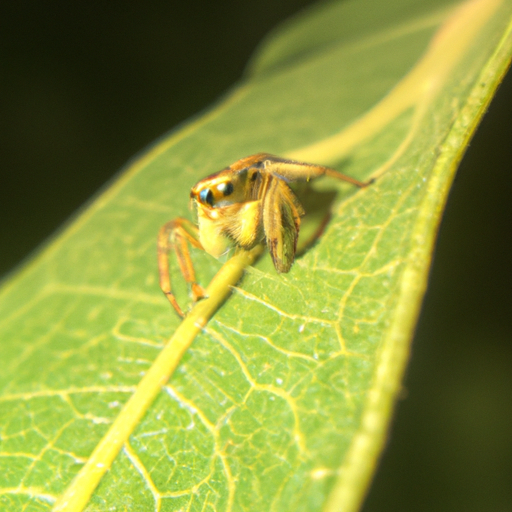Jumping spiders are generally considered friendly to humans. They are not harmful to humans and are too small to cause any serious harm. They are carnivorous and feed on other insects and spiders, but they do not target humans for food.
Contents
Introduction
Jumping spiders, an intriguing member of the arachnid family, often trigger mixed feelings in people. For some, these tiny creatures are nothing short of a nightmare, embodying the common perception of spiders as dangerous or even deadly. This fear, largely due to misinformation and misunderstanding, overshadows the fascinating aspects of these eight-legged wonders.
The primary aim of this article is to challenge such perceptions and explore a rather unusual question: Are jumping spiders friendly? Through this exploration, we hope not only to provide insights into the nature of these remarkable creatures but also to cultivate a sense of understanding and empathy towards them. Rather than focusing on fear or repulsion, we delve into their characteristics, behaviors and interactions with humans.
While it may seem counterintuitive to consider any spider ‘friendly,’ this inquiry invites us all to rethink our assumptions about these often misunderstood creatures. Let’s embark on this journey together, shedding light on the world of jumping spiders and perhaps learning to appreciate their unique place in our ecosystem.
Are Jumping Spiders Friendly?
Jumping spiders are generally considered to be harmless to humans and are not known to be aggressive. In fact, they are often considered to be friendly due to their curious and inquisitive nature. These spiders are known to approach humans and other animals, often jumping onto them to investigate their surroundings. While this behavior may seem intimidating, it is usually harmless and simply a way for the spider to explore its environment.
Identification of Jumping Spiders
One of the most remarkable families within the arachnid class, jumping spiders stand out due to their distinct characteristics. These spiders belong to the Salticidae family, which comprises over 6000 species, making it the largest family of spiders.

Jumping spiders are often small and compact, with most species measuring between 1mm and 25mm. Their bodies are usually brightly colored or patterned. The unique trait that sets these spiders apart is their four pairs of eyes. The front pair, or anterior median eyes, are particularly large and give jumping spiders excellent binocular vision.
“The anterior median eyes of jumping spiders provide them with a nearly 360-degree field of view.”
Several common species of jumping spiders can be found worldwide. Among those, the Phidippus audax or bold jumping spider is quite notable. It’s known for its metallic green chelicerae and distinctive white or orange triangular markings on its abdomen.
Another species worth mentioning is the Cosmophasis umbratica, a tropical jumping spider often found in Asia. This species exhibits sexual dimorphism, meaning males and females appear different — males are shiny and black while females have brown patterns.
Behavior and Curiosity
One fascinating aspect about jumping spiders is their behavior and curiosity. Unlike most spiders that rely on webs to catch prey, jumping spiders use their superior vision and agility to actively hunt during the day. They possess an uncanny ability to estimate distance accurately, allowing them to leap onto their prey from afar.
“Jumping spiders have an impressive hunting technique. They inject venom into their prey through fangs known as chelicerae.“
These tiny creatures are also known for their inquisitive nature. Their excellent vision allows them to observe and explore their environment in detail. They’re often seen climbing up vertical surfaces or even glass windows out of curiosity.
Tolerance and Interaction
When it comes to human interaction, jumping spiders show considerable tolerance compared to other spider types. Generally non-aggressive towards humans, they prefer fleeing rather than attacking when disturbed.
Instances where these arachnids display comfort around humans are not uncommon. Videos online show pet owners handling their jumping spiders without any signs of distress from the creature.
Although not typical pets, some people keep jumping spiders due to their interactive behavior. They have been observed responding to mirrors and camera lenses due to their reflective surfaces — a testament to their curious nature.
Their harmless nature towards humans combined with a significant level of interaction creates a unique dynamic between us and these intriguing creatures.
Health Risks and Bites
When it comes to jumping spiders, the potential health risks they pose is a topic of interest to many. Despite their relatively friendly disposition towards humans, there are concerns related to bites from these creatures.
Risk of Bites
An important fact to note is that jumping spiders are not aggressive by nature. They usually bite only when cornered or threatened, which is rare given their tendency to flee rather than fight. On the off chance you do get bitten, the severity of the bite is typically minimal.
The fangs of a jumping spider are not designed to penetrate human skin deeply. As such, their bites usually result in minor discomfort, akin to a bee sting. Severe reactions are uncommon and often linked with an individual’s specific allergic response.
What to Do if Bitten?
In the event of a bite from a jumping spider:
- Clean the wound with soap and water immediately.
- Apply an ice pack to reduce any swelling.
- Over-the-counter pain relievers can be used for any discomfort.
- Monitor the bite site for any signs of infection or severe reaction.
Symptoms of Jumping Spider Bites
While mild reactions are common, there are several symptoms that one should be aware of:
- Redness around the bite area
- Itching or rash
- Minor swelling
- Mild discomfort or pain
In some rare cases, individuals may have more severe reactions, which could include symptoms such as:
- Difficulty breathing
- Rapid heartbeat
- Swelling of lips, face or throat
- Dizziness or fainting
Any appearance of these severe symptoms warrants immediate medical attention.
By understanding these risks and knowing what to do in case of a bite, one can better appreciate the presence of jumping spiders without undue worry. This knowledge also reinforces the notion that despite being spiders, they pose minimal threat to us humans and can even be considered friendly inhabitants in our shared environment.
In light of this information about health risks and bites associated with jumping spiders, let’s now delve into some practical tips on how you can prevent these fascinating creatures from entering your home in the first place.
How to Prevent Jumping Spiders from Entering Your Home
While jumping spiders pose minimal risk to humans, some people might prefer not to have these eight-legged visitors in their living spaces. Here’s how you can discourage their presence without causing harm.
Practical Tips for Keeping Jumping Spiders Out
- Regular Cleaning: Jumping spiders are attracted to clutter as it makes a good hiding spot. Regular cleaning and decluttering can make your home less appealing to them.
- Seal Cracks and Gaps: Doors, windows, and walls should be checked for any openings. These are the typical entry points for jumping spiders. Use caulk or other sealants to close these gaps.
- Proper Lighting: Jumping spiders tend to avoid bright areas. Keep your home well-lit, especially during the daytime.
Common Entry Points and How to Seal Them Off
Jumping spiders can enter homes through:
- Doors and Windows: Install door sweeps and repair any damaged screens.
- Cracks in Walls: Use a silicone-based caulk to seal off any cracks.
- Vents and Chimneys: Cover these with fine mesh screens.
Natural Deterrents or Traps
There are several humane ways of deterring jumping spiders:
- Essential Oils: Spiders dislike the smell of certain essential oils like peppermint, lavender, and tea tree oil. Mix a few drops with water in a spray bottle and spritz around doors and windows.
- Vinegar: A mixture of white vinegar and water can also deter spiders when sprayed in potential entry points.
- Spider Catchers: Devices designed to catch spiders without harming them can be used if you find a spider indoors.
Remember that jumping spiders play a crucial role in maintaining the ecosystem by controlling pests. They generally mean us no harm, so consider tolerance whenever possible. After all, they’re much more interested in catching flies than frightening humans!
Conclusion
The article’s journey began with an introduction to jumping spiders, countering the common perception of these creatures as scary or dangerous. Jumping spiders, known for their distinctive appearance and unique characteristics, are a diverse group with numerous species. Most importantly, their interaction with humans was discussed, emphasizing their generally harmless nature and their comfort around human presence.
Health risks associated with jumping spiders were also addressed. While bites from these spiders can occur, they are uncommon and usually mild, though severe reactions may occur in rare cases. The symptoms of such bites were outlined, along with advice on when to seek medical attention.
Crucial tips for preventing jumping spiders from entering homes were shared next. From identifying and sealing off common entry points to suggesting natural deterrents or traps, practical suggestions were provided to keep these creatures at bay.
To encapsulate, it is essential to remember that jumping spiders are generally friendly towards humans. Despite their often misunderstood image, they are fascinating creatures deserving of our appreciation and understanding. These eight-legged wonders have much to offer in terms of ecological value and the sheer diversity of life on Earth. As we navigate our shared spaces, may we grow in our knowledge of them, fostering a cohabitative environment marked by respect and kindness.
